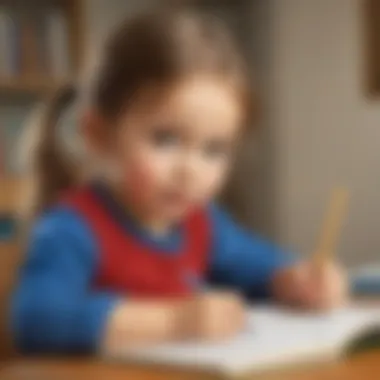Engaging Writing Activities for 4-Year-Olds


Intro
Writing serves as a valuable tool for young children, particularly for four-year-olds. At this age, kids begin to explore their ability to express thoughts and feelings through words. Engaging writing activities can lay the foundation for future literacy skills. These activities are not only fun but also critical for developing fine motor skills and creativity. They allow children to experiment with language, enhancing their vocabulary and comprehension. This article focuses on diverse ideas and methods that can be used at home or in educational settings to foster a love for writing in young learners. By offering various activities, we aim to assist parents and educators in their efforts to encourage early writing skills.
Fun Activities Ideas
Writing does not always have to be a formal activity. Here are some enjoyable methods to encourage writing through play.
Indoor Activities
Children can explore writing indoors in various engaging ways:
- Story Time: Read a variety of picture books that capture their interest. After reading, ask them to create their own short stories based on themes from the books.
- Writing in Sand: Use a tray filled with sand to allow children to practice writing letters and numbers. This tactile experience may help them better remember shapes and strokes.
Outdoor Adventures
Outdoor activities can inspire creativity and writing:
- Nature Journals: Take a notebook outside and encourage your child to draw or write about different plants, animals, or weather elements they observe.
- Scavenger Hunt: Create a list of items to find outdoors, and have the child write down what they discover. This can enhance their observational skills as well.
Arts and Crafts
Integrating writing with arts and crafts can lead to memorable experiences:
- DIY Greeting Cards: Help your child create homemade cards for friends or family. Encourage them to write short messages inside.
- Story Stones: Paint small rocks with different images or words. Let your child use those stones to create a story by arranging them in sequence and writing the accompanying text.
Science Experiments
Engaging children in science encourages curiosity, and writing can help document their findings:
- Experiments Log: Encourage your child to write steps and results when conducting simple science experiments. This not only nurtures their writing but also makes them think critically about processes.
Cooking and Baking
Involving kids in the kitchen can also be a writing opportunity:
- Recipe Book: Create a family recipe book where children can write down their favorite dishes or snacks. They can add illustrations to enhance their descriptions and make it personal.
"Fostering a love for writing in young children does not require rigid methods; it can be achieved through engaging and enjoyable activities that spark their imagination."
By using fun activities tailored to enhance writing skills, parents and educators can cultivate an environment where children feel motivated to express themselves.
Educational Games
Learning through games can make writing enjoyable. Incorporating educational games helps children associate writing with fun and engagement.
Understanding Writing Development in Early Childhood
Writing development in early childhood is a vital area for parents and educators. It lays the groundwork for literacy and communication skills, and it plays a key role in a child's cognitive growth and emotional expression. At this stage, writing is more than just letters on a page; it is a form of self-expression that helps children articulate their thoughts and feelings. Engaging in writing activities helps build confidence and fosters a sense of accomplishment.
The Importance of Writing Skills
Writing skills are essential for several reasons. Firstly, they support literacy development by providing children with an understanding of language structure. This knowledge contributes to reading skills, enabling children to decode text more effectively. Secondly, writing enhances a child's ability to think critically. It requires organization of thoughts and encourages clarity in communication.


Furthermore, writing activities stimulate creativity. Children explore their imagination and tell stories that reflect their world. They learn to convey messages, respond to experiences, and express emotions through their words. All these benefits contribute to a child's overall development, making writing skills an important focus in early childhood education.
Stages of Writing Development
Understanding the stages of writing development is crucial for tailored instruction. Children typically progress through four main stages:
- Scribbling Stage: This begins around 15 months and is marked by random marks on paper. It’s a natural way for children to explore writing.
- Mock Writing Stage: By age 3, children start imitating writing with shapes and lines that resemble letters. They may intentionally create scribbles that look like written words.
- Letters and Words Stage: Between ages 4 and 5, children begin to recognize letters. They may write their names or label objects. Here, phonetic spelling often emerges, showing a grasp of the sound-letter relationship.
- Conventional Writing Stage: By age 5 and beyond, children start forming simple sentences. Their writing becomes more readable and closely resembles adult writing.
Recognizing these stages helps adults provide suitable activities that align with children's writing abilities.
Fine Motor Skills and Writing
Fine motor skills are the small movements that involve the coordination of hands and fingers. Writing requires significant development of these skills. For four-year-olds, engaging in activities that strengthen fine motor skills is critical. This might include:
- Playing with Clay: Molding and shaping can enhance hand strength.
- Using Scissors: Cutting shapes helps improve control and dexterity.
- Stringing Beads: Activities like this can enhance hand-eye coordination.
- Drawing and Coloring: These activities are vital as they foster grip and pencil control.
Through these means, children can find joy in writing while developing the necessary muscle control. This groundwork builds a solid foundation, preparing them for the formal writing tasks that lie ahead.
Choosing Appropriate Writing Materials
Selecting the right writing materials is vital for nurturing a child's budding interest in writing. At the age of four, children are developing their fine motor skills and grasping basic writing concepts. Therefore, providing suitable tools and materials can enhance their learning experience. The right writing materials not only inspire creativity but also allow them to practice writing in a fun and engaging way. This section will cover a variety of tools, types of paper, and suggestions for creating an optimal writing environment for young learners.
Writing Tools for Young Children
The choice of writing tools can significantly impact a child's willingness to write. Young children often struggle with traditional pens and pencils that are designed for older users. Instead, it is essential to provide them with tools that are comfortable and easy to manipulate. Here are some recommended options:
- Thick Crayons: Thicker crayons are easier for small hands to grip. They allow for bold marks and encourage artistic expression.
- Washable Markers: These are great for drawing and writing without the fear of permanent stains. Their rich colors captivate young minds.
- Chunky Pencils: Pencils designed for little hands can help children learn to write letters. Look for triangular or hexagonal shapes for better grip.
- Paint Brushes: These can be used with watercolors or other mediums for artistic letter creation.
These tools align with the children’s developmental needs and can manage frustration levels effectively as they explore writing.
Paper Varieties and Uses
The type of paper available for writing activities can contribute to the overall writing experience. Children benefit from varied paper textures, colors, and formats. Here are some paper options to consider:
- Plain Drawing Paper: This type allows freedom in expression, from scribbles to pictures.
- Lined Paper: Offering wider lines can help kids practice their letters more clearly. This is more suited for children who are a bit advanced in their writing skills.
- Graph Paper: A great choice for teaching basic shapes and spatial awareness. Kids can practice writing letters inside the squares.
- Construction Paper: Ideal for collage activities, this can also serve as a backdrop for a child’s written words on drawings.
Providing an array of paper types encourages children to experiment with different writing styles and formats as they create.
Creating a Writing Space
Setting up a dedicated writing space is crucial to foster a writing habit in young children. A well-organized and inviting area can motivate them to engage with writing activities. Consider the following aspects when creating this space:
- Location: Find a quiet area within the house where distractions are minimal. This helps children focus on their writing tasks.
- Comfortable Seating: Use a child-sized table and chair. Comfort is key in encouraging them to sit and write for longer periods.
- Accessibility of Materials: Keep writing tools and paper within easy reach. Such accessibility allows children to grab materials spontaneously, leading to more creativity.
- Visual Inspiration: Adorn the space with visual aids, such as letters, numbers, or pictures of writing tools. Such visuals can inspire children and spark their imagination.
- Storage: Designate boxes or shelves for their creations and materials. An organized space can significantly enhance their writing experience.
Creating an inviting writing space can inspire children to explore their creativity and develop their writing skills in a comfortable environment.
Engaging Writing Activities
Engaging writing activities are essential for four-year-olds as they motivate children to explore their creativity while building foundational writing skills. These activities provide avenues for self-expression and enable young learners to develop a positive attitude towards writing. Children at this age are naturally curious, and activities that captivate their interest will effectively promote literacy and fine motor development.
Introducing writing in fun and interactive ways helps children associate the process with pleasure rather than a chore. Through play and exploration, children learn essential letters, words, and symbols. In addition, these activities typically require the use of hands, which enhances fine motor skills. Activities can be adjusted to suit different levels of ability, allowing all children to participate meaningfully.
Ultimately, the right engaging writing activities can lay the groundwork for a lifelong love of writing and reading. Let us delve into some specific activities that can be beneficial.
Sand and Salt Writing


This activity involves spreading sand or salt on a flat surface and letting children use their fingers to write letters or words. The texture of the sand creates a tactile experience that is delightful for young learners. It promotes sensory exploration while developing hand-eye coordination. Moreover, when kids make mistakes, it is simple for them to shake and start again, making it a low-pressure environment for practicing writing.
Finger Painting Letters
Finger painting letters is a delightful creative activity. Parents can outline letters or shapes using paint, and children can fill them in using their fingers. This technique encourages artistic expression while reinforcing letter recognition. When children see their colorful creations, it enhances their motivation to practice writing. The combination of art and writing can trigger enthusiasm in children who may be less inclined toward traditional writing practices.
Sticker Storytelling
Sticker storytelling involves using stickers to create narratives. Children can arrange stickers on paper and then dictate a short story related to their arrangement. This activity not only encourages writing but also sparks imaginative thinking. By guiding them to write down their stories, educators and parents can connect creative play with writing skills. Children will often focus on elements like characters and settings while expressing themselves.
Creating a Visual Alphabet Book
A visual alphabet book is an excellent project that combines learning and crafting. In this activity, children can create a book using pages dedicated to each letter of the alphabet. Children can draw, cut out images, or use photographs to represent objects that begin with each letter. The process of assembling the book fosters a deeper understanding of the alphabet while connecting visuals to letters. This also nurtures a sense of accomplishment once the book is completed.
Letter Tracing Activities
Letter tracing activities are another effective way to build writing skills. These can be done with various materials, such as worksheets, sandpaper letters, or even tracing in the air. The physical action of tracing shapes and letters helps children develop muscle memory. As children gain confidence through tracing, they can transition to writing independently. Incorporating fun tools like colored pencils or dots can further grab their attention and enthusiasm.
Interactive Journaling
Interactive journaling encourages children to document their experiences and thoughts. This can be done through drawings, using stickers, and simple words. Journaling promotes literacy and allows children to reflect on their day-to-day lives creatively. It also showcases a child's growth over time as they become more skilled in writing. Journals can be personalized, and some children may even appreciate the idea of keeping their thoughts private.
Engaging writing activities not only enhance skills but also create opportunities for children to discover the joy of writing. Such activities form the bedrock for future literacy development, fostering a nurturing environment conducive to growth.
Incorporating Writing into Daily Routine
Incorporating writing into daily routines for four-year-olds is essential for fostering their literacy skills and creativity. This practice seamlessly integrates writing into the flow of everyday life, making it an organic part of their experiences. Engaging young children in writing activities that are relatable and relevant encourages them to express thoughts and ideas, enhancing their understanding of language in a practical context.
Writing in routine scenarios not only stimulates interest but also offers several benefits. It assists in developing fine motor skills as children manipulate tools to write or draw. Moreover, it reinforces vocabulary as they encounter and create words frequently. Routine writing tasks make children feel more confident in their abilities, promoting a positive attitude towards writing.
For parents and educators, it is vital to recognize that each child's needs vary. Monitoring their preferences and adapting activities can maximize their engagement and progress in writing. This section delves into specific activities that can easily be incorporated into daily activities.
Writing Shopping Lists
Writing shopping lists is a practical and fun activity for young children. It allows them to connect words with objects they see every day. When going to the store, a child can help in creating a list of items needed, like fruits or snacks. This encourages them to recognize words and understand their meanings, linking writing to real-world experiences.
Parents can guide them by using a whiteboard or a piece of paper. Asking questions like, "What do you think we need?" makes it interactive. Involving the child in the process fosters ownership of their writing.
- Benefits of writing shopping lists:
- Enhances vocabulary and recognition of common items.
- Promotes early planning and organizational skills.
- Encourages teamwork between parent and child.
Making Greeting Cards
Making greeting cards is another enjoyable writing activity for children. This task can help children use writing for expression. Children can create cards for birthdays, holidays, or simply to say thank you. Writing short messages or drawing pictures inside these cards encourages creativity and personal connection.
Providing materials like colorful paper, crayons, and stickers invites children to use various tools, enhancing their fine motor skills. Parents can assist by suggesting phrases or topics, but allowing children to choose their own designs fosters independence.
- Key elements in making greeting cards:
- Creativity: Personalize cards with drawings and messages.
- Encouragement: Praise efforts to motivate further creativity.
- Sharing: Presenting cards teaches them about social interactions.
Labeling Household Items
Labeling household items is a simple yet effective writing activity. It helps children learn the names of things in their environment. For example, a parent can encourage the child to help label objects like the fridge, door, or toys. This practical approach makes writing relevant by directly engaging with the home setting.


Creating labels can involve writing the names on sticky notes or small pieces of paper and placing them next to the items. This not only aids literacy but also helps children take ownership of their home. Every time they see the label, they enhance their recognition of that word.
- Advantages of labeling items:
- Establishes connection between words and objects.
- Reinforces sight word recognition through repetition.
- Encourages tidiness as children start to keep things in labeled places.
Incorporating writing into everyday routines allows children to learn in engaging and meaningful ways, enhancing their connection with language.
Integrating Technology in Writing Activities
Integrating technology into writing activities for four-year-olds can bring significant benefits. Technology can make writing engaging and interactive. Young children are often drawn to screens, and combining this interest with educational tools can promote literacy. Moreover, it provides opportunities for varied learning styles. Using technology can help develop fine motor skills in a new context. However, it is crucial to balance screen time with hands-on activities to ensure a well-rounded writing experience.
Using Writing Apps
Writing apps cater specifically to young learners. These applications often feature fun graphics and sound effects that keep children engaged. Children can practice letter formation through tracing activities designed in a game-like format. For instance, apps like "Writing Wizard" allow kids to form letters by tracing them, reinforcing both the shape and direction of writing. Many apps also include customizable options, enabling parents to input their child’s name or favorite characters. This personalization makes the activity more relatable for the child and encourages continued usage.
Digital Storytelling Tools
Digital storytelling tools allow children to create narratives using images, text, and audio. Platforms such as "Storybird" or "Book Creator" provide an interactive writing experience. Kids can combine artwork with their words, which enhances creativity and self-expression. These tools often guide children through the process of structuring a story. They can select backgrounds, characters, and settings, promoting imaginative thinking. Furthermore, they can share their stories with family or friends, fostering a sense of pride in their writing achievements.
Sharing Writing Online Safely
When using technology, safety is paramount. Teaching children how to share their writing online safely is essential. Parents should set clear guidelines on what is safe to share and with whom. Public forums should be approached cautiously. Encouraging private sharing with trusted family members or friends can allow children to gain feedback without compromising their safety. Platforms with strict privacy settings are recommended for young users. Additionally, parents can engage with children during online sharing moments to ensure they understand the importance of digital privacy.
Engaging with technology in writing activities is more than just using apps; it is about providing children with skills they will use throughout their lives. Teaching them to navigate online spaces safely is as crucial as nurturing their writing skills.
Building a Supportive Writing Environment
Creating a supportive writing environment is crucial for young learners. The right setting can encourage children to engage more actively in writing activities. It helps them feel motivated, confident and willing to express their thoughts through written words. Parents and educators play a pivotal role in establishing this environment. A few key elements to consider include organization, accessibility, and comfort.
Firstly, the writing space should be organized. All writing materials must be easily accessible. This includes a variety of tools such as crayons, markers, and pencils. Likewise, it is important to have different types of paper. Consider using plain paper, lined paper, or fun stationery. Having choices enhances children's interest and creativity.
Moreover, minimizing distractions in the writing area fosters better focus. Keep this space away from noisy areas, ensuring that children can concentrate on their writing tasks.
Another important factor is comfort. A cozy chair and table set up that suits a child's size can make them feel at ease. Providing a comfortable environment can enhance their willingness to write.
"A supportive environment not only promotes writing but also nurtures a love for literacy in children."
This sanctuary for writing should be filled with inspiration. Displaying letters, words, or even children's previous work is motivating. Such visual aids create a stimulating atmosphere.
Encouragement of expression and creativity is essential in this setting. Children should feel free to explore their ideas without fear of judgment. This mindset allows them to take risks in their writing journeys.
Evaluating Progress and Encouragement
Evaluating progress in writing activities for four-year-olds is crucial for understanding a child's development. It aids parents and educators in recognizing which skills have been acquired and which areas require more focus. Encouragement plays an equally significant role in maintaining a child's enthusiasm and motivation towards writing. When children see that their efforts are noticed and valued, they are more likely to engage in activities with joy.
Observing Writing Skills Development
Observing a child's writing development involves more than watching them hold a crayon. It requires parents and educators to assess various aspects of their writing. Observations can include:
- Fine Motor Skills: Assess how well the child can manipulate writing tools. Are they able to grasp crayons or markers effectively?
- Letter Recognition: Notice if the child can identify and write letters of the alphabet. This is a foundational skill in writing.
- Spelling and Vocabulary: Pay attention to the words children choose when they write. Are there repetitions or new words introduced?
- Creativity: Evaluate the range of ideas presented in their writing. Are they able to express personal thoughts and stories?
Regular observation can provide insights into a child's interests and natural inclinations, which can inform future activities.
Adjusting Activities to Fit Learner's Needs
Every child learns differently. Adjusting writing activities to meet individual needs is essential. Consider the following strategies:
- Modify Complexity: If a child struggles with tracing letters, consider activities that involve larger movements, such as drawing in sand or using bigger crayons.
- Incorporate Interests: If a child loves animals, related writing tasks can engage them more deeply. This could involve creating stories about their favorite animals or labeling pictures.
- Vary Tools and Materials: Some children may respond better to digital tools, while others prefer traditional methods. Introducing both can enhance personalized learning.
- Use Positive Reinforcement: Celebrate small victories with praise or tangible rewards. This encouragement motivates children to keep improving.
By focusing on observing skills and adapting activities, parents and teachers can create a supportive writing environment. This method not only nurtures writing skills but also fosters confidence in young learners.



